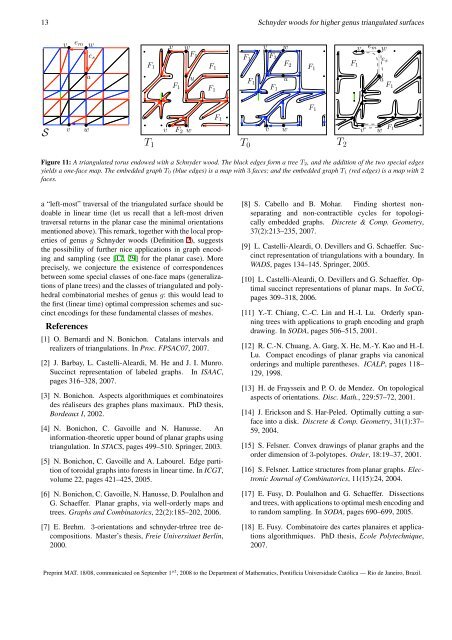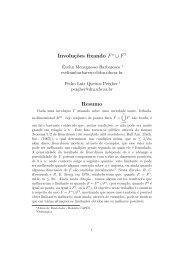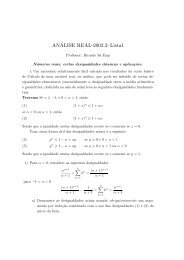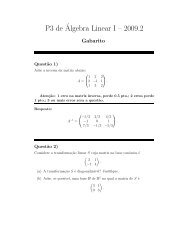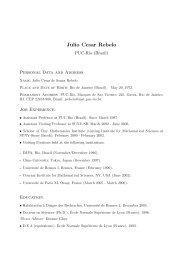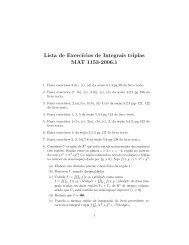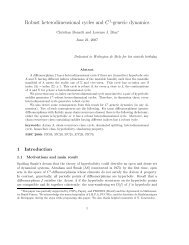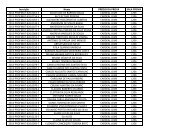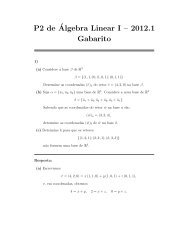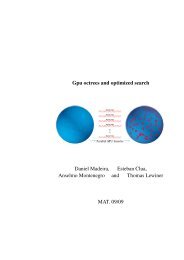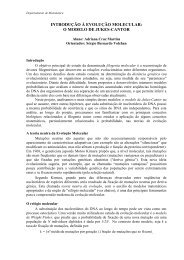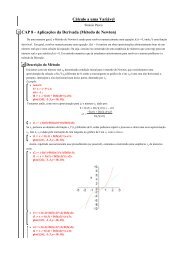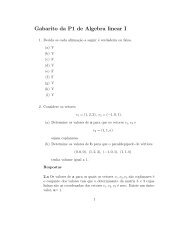Schnyder woods for higher genus triangulated surfaces with ...
Schnyder woods for higher genus triangulated surfaces with ...
Schnyder woods for higher genus triangulated surfaces with ...
You also want an ePaper? Increase the reach of your titles
YUMPU automatically turns print PDFs into web optimized ePapers that Google loves.
13 <strong>Schnyder</strong> <strong>woods</strong> <strong>for</strong> <strong>higher</strong> <strong>genus</strong> <strong>triangulated</strong> <strong>surfaces</strong><br />
S<br />
v<br />
v<br />
e m<br />
u<br />
w<br />
w<br />
e s<br />
v w<br />
v w<br />
v e m w<br />
F 1<br />
F 1<br />
F 3<br />
e<br />
F 1 F F 2<br />
F<br />
F s<br />
1<br />
1<br />
1<br />
u<br />
F 1<br />
u<br />
u<br />
F 1 F 1<br />
F 1<br />
F 1<br />
F 1<br />
F 1<br />
v F 2 w<br />
v w<br />
v w<br />
F 1<br />
T 1 T 0 T 2<br />
Figure 11: A <strong>triangulated</strong> torus endowed <strong>with</strong> a <strong>Schnyder</strong> wood. The black edges <strong>for</strong>m a tree T 2 , and the addition of the two special edges<br />
yields a one-face map. The embedded graph T 0 (blue edges) is a map <strong>with</strong> 3 faces; and the embedded graph T 1 (red edges) is a map <strong>with</strong> 2<br />
faces.<br />
a “left-most” traversal of the <strong>triangulated</strong> surface should be<br />
doable in linear time (let us recall that a left-most driven<br />
traversal returns in the planar case the minimal orientations<br />
mentioned above). This remark, together <strong>with</strong> the local properties<br />
of <strong>genus</strong> g <strong>Schnyder</strong> <strong>woods</strong> (Definition 2), suggests<br />
the possibility of further nice applications in graph encoding<br />
and sampling (see [17, 29] <strong>for</strong> the planar case). More<br />
precisely, we conjecture the existence of correspondences<br />
between some special classes of one-face maps (generalizations<br />
of plane trees) and the classes of <strong>triangulated</strong> and polyhedral<br />
combinatorial meshes of <strong>genus</strong> g: this would lead to<br />
the first (linear time) optimal compression schemes and succinct<br />
encodings <strong>for</strong> these fundamental classes of meshes.<br />
References<br />
[1] O. Bernardi and N. Bonichon. Catalans intervals and<br />
realizers of triangulations. In Proc. FPSAC07, 2007.<br />
[2] J. Barbay, L. Castelli-Aleardi, M. He and J. I. Munro.<br />
Succinct representation of labeled graphs. In ISAAC,<br />
pages 316–328, 2007.<br />
[3] N. Bonichon. Aspects algorithmiques et combinatoires<br />
des réaliseurs des graphes plans maximaux. PhD thesis,<br />
Bordeaux I, 2002.<br />
[4] N. Bonichon, C. Gavoille and N. Hanusse. An<br />
in<strong>for</strong>mation-theoretic upper bound of planar graphs using<br />
triangulation. In STACS, pages 499–510. Springer, 2003.<br />
[5] N. Bonichon, C. Gavoille and A. Labourel. Edge partition<br />
of toroidal graphs into <strong>for</strong>ests in linear time. In ICGT,<br />
volume 22, pages 421–425, 2005.<br />
[6] N. Bonichon, C. Gavoille, N. Hanusse, D. Poulalhon and<br />
G. Schaeffer. Planar graphs, via well-orderly maps and<br />
trees. Graphs and Combinatorics, 22(2):185–202, 2006.<br />
[7] E. Brehm. 3-orientations and schnyder-trhree tree decompositions.<br />
Master’s thesis, Freie Universitaet Berlin,<br />
2000.<br />
[8] S. Cabello and B. Mohar. Finding shortest nonseparating<br />
and non-contractible cycles <strong>for</strong> topologically<br />
embedded graphs. Discrete & Comp. Geometry,<br />
37(2):213–235, 2007.<br />
[9] L. Castelli-Aleardi, O. Devillers and G. Schaeffer. Succinct<br />
representation of triangulations <strong>with</strong> a boundary. In<br />
WADS, pages 134–145. Springer, 2005.<br />
[10] L. Castelli-Aleardi, O. Devillers and G. Schaeffer. Optimal<br />
succinct representations of planar maps. In SoCG,<br />
pages 309–318, 2006.<br />
[11] Y.-T. Chiang, C.-C. Lin and H.-I. Lu. Orderly spanning<br />
trees <strong>with</strong> applications to graph encoding and graph<br />
drawing. In SODA, pages 506–515, 2001.<br />
[12] R. C.-N. Chuang, A. Garg, X. He, M.-Y. Kao and H.-I.<br />
Lu. Compact encodings of planar graphs via canonical<br />
orderings and multiple parentheses. ICALP, pages 118–<br />
129, 1998.<br />
[13] H. de Fraysseix and P. O. de Mendez. On topological<br />
aspects of orientations. Disc. Math., 229:57–72, 2001.<br />
[14] J. Erickson and S. Har-Peled. Optimally cutting a surface<br />
into a disk. Discrete & Comp. Geometry, 31(1):37–<br />
59, 2004.<br />
[15] S. Felsner. Convex drawings of planar graphs and the<br />
order dimension of 3-polytopes. Order, 18:19–37, 2001.<br />
[16] S. Felsner. Lattice structures from planar graphs. Electronic<br />
Journal of Combinatorics, 11(15):24, 2004.<br />
[17] E. Fusy, D. Poulalhon and G. Schaeffer. Dissections<br />
and trees, <strong>with</strong> applications to optimal mesh encoding and<br />
to random sampling. In SODA, pages 690–699, 2005.<br />
[18] E. Fusy. Combinatoire des cartes planaires et applications<br />
algorithmiques. PhD thesis, Ecole Polytechnique,<br />
2007.<br />
Preprint MAT. 18/08, communicated on September 1 st , 2008 to the Department of Mathematics, Pontifícia Universidade Católica — Rio de Janeiro, Brazil.


